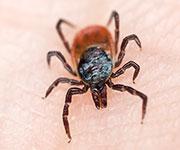
FRIDAY, Feb. 27, 2015 (HealthDay News) — Ticks in the northeastern United States are showing up earlier in the spring and expanding their range because of warmer temperatures over the past two decades, experts say.
Although the Northeast is currently contending with record-breaking cold, the trend over the past 19 years has been toward warmer temperatures, the researchers explained. And this is enabling black-legged ticks that carry Lyme disease and other infections to begin feeding several weeks earlier than usual, the investigators found.
This could increase the risk for Lyme disease over the coming decades, the researchers said.
“The risk is changing with climate change. We need to prepare ourselves for tick avoidance education earlier in the season,” said research co-author Richard Ostfeld, a senior scientist with the Cary Institute of Ecosystem Studies in Millbrook, N.Y.
“The fact of the matter is that avoidance of infected ticks is the only game in town,” Ostfeld said.
The institute sits in the middle of tick country near the Hudson River, about 90 minutes upstate from New York City. In one of two new studies, researchers analyzed statistics gleaned from tens of thousands of mice and chipmunks trapped in the area between 1994 and 2012.
Tick season began earlier by nearly three weeks in warmer years — from early June to late May, Ostfeld said.
Of course it’s tough to definitely prove that climate change is causing a boom in tick populations. But Ostfeld believes that if temperatures continue to climb, tick season may begin even earlier. “Within a few decades, it will shift all the way to early May,” he said.
The nymph stage of development — when ticks are the size of a poppy seed — is when ticks are the greatest threat to humans. Nymphs are “the guys who make us sick and are responsible for the majority of human cases of Lyme disease,” Ostfeld said.
Besides Lyme disease, black-legged ticks can cause babesiosis and anaplasmosis, both potentially life-threatening infections, and encephalitis, an inflammation of the brain, the study authors noted.
Lyme disease is a major public health threat in the Northeast and Midwest, the researchers pointed out.
But warming temperatures are making it easier for ticks to survive in higher altitudes and northern areas that would normally be too cold for them, the researchers concluded after reviewing scientific research.
“Lyme is expanding geographically, moving northward and moving up in elevation,” Ostfeld said. This means it’s likely to spread into western New York (Syracuse, Buffalo, Rochester), western Pennsylvania (Pittsburgh), southern Canada (Quebec and Ontario) and the mountains of New England, he said.
Sam Telford, a professor of infectious disease and global health at Tufts University in Boston, praised the study and said it doesn’t exaggerate the risk of climate change.
But Telford cautioned that a lot can happen over decades.
“The Lyme disease epidemic started in the early 1970s, 40 years ago,” he said. “By 2040, we will have a vaccine, and we will have better repellents and insecticides.”
What about this spring in the Northeast? It won’t necessarily be a good year for people who want to avoid Lyme disease, he said.
“A lot of people think the silver lining is that hopefully the ticks will get clobbered because it’s so cold. But we don’t find evidence of cold weather conditions having an effect on tick populations,” Telford said.
Also, he said, a heavy layer of snow can provide a protective blanket for ticks on the ground.
Ostfeld’s advice for keeping ticks at bay once the snow melts: “Use a DEET repellent, the same ones you’d use for mosquitos. Do tick checks if you’ve been out hiking or walking your dog in the woods or shrubs. Pull them off before they bite you for very long. Wear long pants with closed shoes.”
Also, learn about the early symptoms of Lyme disease, he said. These include a rash at the site of the tick bite, fatigue, chills, fever and muscle and joint aches, according to the U.S. Centers for Disease Control and Prevention.
The studies were published Feb. 18 in the journal Philosophical Transactions of the Royal Society B.
More information
For details about Lyme disease, see the U.S. Centers for Disease Control and Prevention.
Copyright © 2025 HealthDay. All rights reserved.

